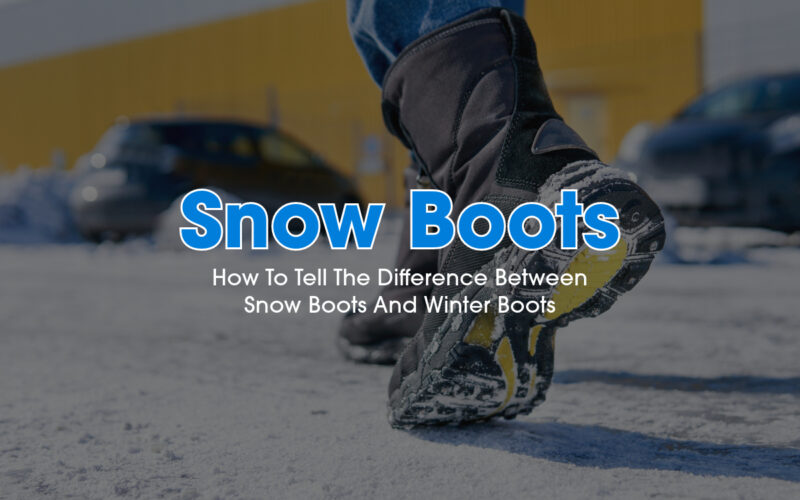How To Tell The Difference Between Snow Boots And Winter Boots

What are snow boots?
Snow boots are a type of footwear specifically designed to provide warmth, traction, and protection from snow and cold weather conditions. They typically feature insulation to keep the feet warm, waterproof or water-resistant materials to keep moisture out, and sturdy outsoles with deep treads for traction on snowy or icy surfaces. Snow boots come in various styles, from ankle-length to knee-high, and are commonly worn during winter activities such as snowshoeing, skiing, snowboarding, hiking, or simply for everyday winter wear in regions with cold climates. They are essential for keeping feet comfortable and safe in snowy and icy conditions.
Snow Boots Vs Winter Boots - What’s the Difference?
Snow boots and winter boots are terms that are often used interchangeably, and while they share similarities, there are some differences between them.
Winter Boots
- Winter boots are a broader category of footwear designed to provide warmth and protection in cold weather conditions, which may or may not include snow.
- They are suitable for various winter activities beyond just walking in snow, such as everyday wear in cold climates or activities like hiking, ice fishing, or shoveling snow.
- Winter boots may not always have the same level of insulation or traction specifically tailored for deep snow and icy conditions.
Snow Boots
- Snow boots are a subset of winter boots that are specifically designed to provide superior traction and insulation for walking in deep snow and icy conditions.
- They typically have features such as waterproof or water-resistant materials, extra insulation, and deep treads on the outsoles for enhanced grip on snow and ice.
- Snow boots are often more specialized for activities directly involving snow, such as skiing, snowboarding, snowshoeing, or playing in the snow.
While winter boots encompass a broader range of cold-weather footwear, snow boots are a specific type of winter boot tailored for walking in deep snow and icy conditions, with features optimized for such environments.
Can you walk with snow boots?
Yes, you can definitely walk in snow boots. In fact, walking is one of the primary activities for which snow boots are designed. Snow boots are specifically engineered to provide traction, warmth, and protection in snowy and icy conditions, making them ideal for walking in winter weather.
Here are a few reasons why snow boots are well-suited for walking:
- Traction: Snow boots typically feature rugged outsoles with deep treads or lugs that provide excellent grip on snow and ice. This helps you maintain stability and prevent slipping while walking on slippery surfaces.
- Insulation: Snow boots are insulated to keep your feet warm in cold temperatures. The insulation helps retain body heat and prevent your feet from getting cold while walking in snowy conditions.
- Waterproofing: Many snow boots are made with waterproof or water-resistant materials to keep your feet dry when walking through snow or slush. This helps protect your feet from moisture and keeps them comfortable during extended periods of walking.
- Support and Comfort: Snow boots often have features like cushioned insoles, supportive midsoles, and padded collars or tongues, which provide comfort and support for walking long distances.
- Protection: Snow boots typically have a higher shaft height than regular shoes, which helps keep snow out and provides extra protection for your ankles and lower legs while walking in deep snow.
Overall, snow boots are designed to be functional and comfortable for walking in snowy and icy conditions, making them an essential piece of footwear for winter activities such as hiking, snowshoeing, or simply navigating snowy sidewalks.
Can you wear snow boots without snow?
Yes, you can wear snow boots without snow, and many people do so for a variety of reasons.
- Cold Weather: Snow boots are designed to provide warmth and insulation, making them suitable for cold weather even in the absence of snow. If temperatures drop below freezing, wearing snow boots can help keep your feet warm and comfortable.
- Rainy Conditions: Snow boots are often waterproof or water-resistant, making them suitable for rainy or wet conditions as well. They can help keep your feet dry and protected from moisture, even if there’s no snow on the ground.
- Outdoor Activities: Snow boots offer excellent traction and stability, which can be beneficial for outdoor activities like hiking, camping, or working in rugged terrain. They provide protection and support for your feet in various environments, not just snowy ones.
- Fashion and Style: Some people wear snow boots as a fashion statement or for their unique style, even when there’s no snow. Many snow boots come in trendy designs and colors that can complement casual or outdoor outfits.
- Comfort and Support: Snow boots often feature cushioning, arch support, and other comfort features that make them suitable for everyday wear, regardless of the weather. They can provide all-day comfort and support for activities like walking or running errands.
While snow boots are designed with snow and cold weather in mind, they offer versatility and functionality that make them suitable for wearing in various conditions beyond just snowy ones.











